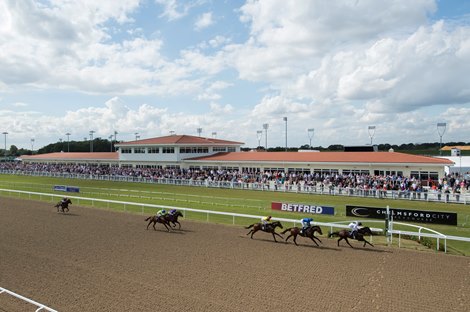Changes to the stop-race protocol in Britain have been called for by those involved in a race Nov. 9 in which horses narrowly avoided colliding with a set of starting stalls left stranded on the track by a malfunctioning tractor.
Quick-acting jockeys were able to take evasive action to prevent catastrophe at Chelmsford, having been alerted to the unexpected presence of the stalls by the frantic flag-waving of the starter, who had run down the course to the home bend to alert the riders.
Despite traveling at speeds approaching 40 mph as they approached the home straight, the horses and jockeys were able to pull up in around 100 meters before reaching the obstacle, which was stuck on the track between the two- and one-furlong markers.
In a statement released after the race, Chelmsford said the incident was “unprecedented” and that it was “deeply relieved” no one came to harm. It added: “Although the racecourse was not directly responsible for what occurred, we fully acknowledge our role as the racecourse staging the fixture”.
Jane Chapple-Hyam, who saddled Salamanca in the handicap, said the tractor used to pull the stalls off the course after the start “wouldn’t go into gear” and that officials “didn’t have enough time” to send anyone to flag down the riders when the horses were in the back straight.
Harry Davies, who rode Intricacy, and Daniel Kubler, who trains Andaleep in partnership with his wife, Claire, both expressed a desire to see the stop-race system changed to ensure riders could be alerted more quickly to reduce the possibility of a repeat of Saturday’s events.
Sign up for BloodHorse Daily
Davies said: “I’m very thankful that everyone was able to pull up okay—that’s the big relief of it all. I spotted the flag as we were coming around the bend, and all of the jockeys started shouting to pull up as fast as you can because there was only about half a furlong to do it in before you got to where the stalls were.
“The biggest thing which struck us was that there hadn’t been someone with a flag on the back straight and we were all a bit confused as to why that was the case. Speaking afterwards, that’s what we all felt should be the case for races like this in the future where they go round past the start.
“It’s quite miraculous something didn’t happen and they were all good horses with good mouths who responded quickly to us. Younger or more inexperienced horses tend to run with their blood up and can’t always be pulled up so quickly, so we were lucky in many ways.”
Kubler said: “When you have races where they are going round twice, do you need someone away from the stalls that can provide a warning to jockeys earlier?
“Other countries have much more obvious warning signs. James (Finch), who owns Andaleep, has horses in France and they have sirens and flashing lights, for example, to let jockeys know.
“Ultimately, it’s hard to apportion blame to anyone, but the sport needs to be as safe as it can possibly be, and there’s definitely elements that can be improved in terms of warning riders when something is wrong. That’s the key point from all of this.”
The race was voided, with stewards interviewing a number of parties in an attempt to determine why the stalls had been stranded. A report was forwarded to the BHA, where further investigations will take place into how the stop-race protocol was enacted and what other factors may have contributed to what happened.

